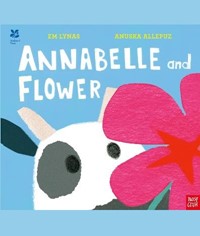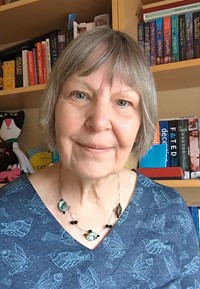Em Lynas explores life cycles and emotions in Annabelle and Flower


About Author
Em Lynas explores life cycles, the seasons and our emotions in her new picture book, Annabelle and Flower.
Em is a children's author with a love of silly poetry, magic, dragons and folklore. Em has been a shelf stacker, a shoe shop assistant, a primary school teacher, a mum, an educational publisher and now, an author of funny books.
She lives by the seaside on the North East coast with her husband, Geoff, and although she did have pets when her children lived at home; hamsters, guinea pigs, a rabbit and a jar of stick insects, she is currently petless.
Interview
Em Lynas explores emotions and life cycles through Annabelle and Flower (Nosy Crow)
February 2025
Picture book creator Em Lynas introduces her new picture book, Annabelle and Flower, which follows what happens when a lonely cow discovers a solitary flower in its field, and the changes this brings.
ReadingZone spoke with Em to find out how the book can be used with young children to explore emotions as well as changing seasons and life cycles. We also asked Em for activities to explore these themes further with young children.
Q&A with Em Lynas: Using Annabelle & Flower to explore emotions and life cycles
"I'm hoping it will allow them to understand emotions, to discuss the moments of joy and sadness that
Annabelle experiences, and to develop empathy for others."
1. Hello Em, can you tell us a little about yourself and what brought you into creating books for children?
I'm an ex-teacher and I spent most of my career with reception children so I have a love of picture books, especially rhyming picture books. I love the way children interact with them and respond to the rhymes and rhythms and emotions of the stories. I especially enjoyed the funny books and now I have my own! It's an excuse to be silly.
2. What happens in Annabelle and Flower, and what was the inspiration behind the story?
When a lonely cow called Annabelle finds a tiny flower one spring day, it brings a dance to her step and a smile to her moo. Over time, the flower grows, blooms and changes colour, until one day autumn comes and blows all the petals away. Poor Annabelle is alone again, until spring returns and she finds a new flower . . . and another . . . and another!
I first thought of the story when I was re-reading Charlotte's Web by E. B. White and got to the moment when Charlotte the spider dies and Wilber the pig is devastated but then, of course, Charlotte has laid eggs and when spring comes the eggs hatch and the cycle goes on. It's such an emotional moment and I wanted to recreate that somehow. I'm not sure why but a cow and a flower came to mind. I always describe it as a love story between a cow and a flower.

3. How does the story help children learn about seasons and life cycles?
The seasons and changes in the weather are mentioned throughout the book and the illustrations, by Anuska Allepuz, beautifully express the changes. I think the book can be used as a starting point to discuss a range of life cycles, changes and emotions.
4. Why did you decide to approach these themes through a story about a cow in a field?
I don't remember if there was a trigger; it just felt right. I needed a lonely animal that could express emotion and a cow seemed the right choice. I also kept seeing an image of a cow sniffing a flower and falling in love.
It wasn't difficult to write but it took a while to get right. I knew I didn't want any dialogue and the voice and tone was really important, it needed to rise and fall with the seasons and emotions.
5. What kinds of discussions do you hope that Annabelle and Flower will prompt with children?
I'm hoping it will allow them to understand emotions, to discuss the moments of joy and sadness that Annabelle experiences and to develop empathy for others.

6. Can you suggest any activities to take the story further?
Oh gosh, there are so many! Here are a few ideas:
· Read other books that explain life cycles, the most obvious being The Very Hungry Caterpillar.
· Explore flowers - colour, shapes, sizes, number of petals, texture of petals, parts of the flower etc
· Read other books that explore emotions, the most obvious, to me, is Barbara Throws a Wobbler by Nadia Shareen, one of my favourites.
· Paint/draw emotions, what colours would you use for sadness?
· Drama - explore the body language of emotion. We don't just show it our faces, we show it in our whole bodies. Jump for joy! Slump for sadness.
7. What do Anoushka Allepuz's illustrations bring to this gentle story for young children? Do you have a favourite spread?
They are amazing and so beautiful. Seeing my words come to life through an illustrator's perspective is one of my favourite moments as a picture book author. Anuska created an Annabelle who is gorgeous and relatable and the flower spreads are just WOW! My favourite spread though is the winter spread when Annabelle is all alone in a field of snow and sadness. It truly expresses her grief and loneliness.

8. Do you have any more adventures planned for Annabelle - and Rosie? What are you writing currently?
There are no Annabelle and Rosie books planned at the moment but I'm hoping to work with the National Trust again on a book I can't mention yet. I'm also working on a book of poems with a particular theme which, again, I can't tell you about!
But I can tell you about a book that's coming out soon. The Bear and the Hare and the Fair is coming out in May and it's the next in The Goat and the Stoat and the Boat, and The Cat and the Rat and the Hat series.
9. What kinds of things do you enjoy doing when you're not writing? Where do you go for inspiration?
I'm trying to get back to painting and drawing, not with a view to illustrating my own books, just for my own enjoyment. So I'm signing up to a few online courses to get me motivated!
Inspiration can come from anywhere but it's good to get out and about in nature. If I walk on my own I find ideas flow but if I walk with others I talk too much.
10. School events: Are you offering school events for Annabelle and Flower? What are your contact details for schools that would like to find out more?
I'm not doing live school events but I am available for zoom events. I can be contacted on Bluesky @EmLynas.
Other books by Em Lynas:
D is for Dog (Nosy Crow)
Author Em Lynas shares the start of D is for Dog, and suggests how to encourage children in creating their own rhymes: 'A is for action and B is for bark; C is for catching a ball in the park . . .' Join the rhyming fun in this alphabet book packed with dogs' playfulness, fun and everyday activities. D is for Dog is a must-have picture book for anyone with a dog in the family. It's also a brilliant starting point for encouraging young children to explore rhymes and rhyming words. Em adds, "I've tried to make the book interactive, so I hope a reading of the book creates a noisy and active classroom with children barking and doing the actions. Total chaos!"
 National Trust: Annabelle and Flower
National Trust: Annabelle and Flower
 D is for Dog
D is for Dog
 The Goat and the Stoat and the Boat
The Goat and the Stoat and the Boat
 The Cat and the Rat and the Hat
The Cat and the Rat and the Hat
